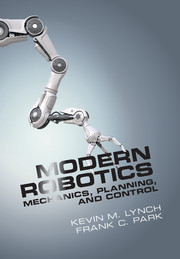Book contents
- Frontmatter
- Contents
- Foreword by Roger Brockett
- Foreword by Matthew Mason
- Preface
- 1 Preview
- 2 Configuration Space
- 3 Rigid-Body Motions
- 4 Forward Kinematics
- 5 Velocity Kinematics and Statics
- 6 Inverse Kinematics
- 7 Kinematics of Closed Chains
- 8 Dynamics of Open Chains
- 9 Trajectory Generation
- 10 Motion Planning
- 11 Robot Control
- 12 Grasping and Manipulation
- 13 Wheeled Mobile Robots
- A Summary of Useful Formulas
- B Other Representations of Rotations
- C Denavit–Hartenberg Parameters
- D Optimization and Lagrange Multipliers
- Bibliography
- Index
Foreword by Matthew Mason
Published online by Cambridge University Press: 04 June 2024
- Frontmatter
- Contents
- Foreword by Roger Brockett
- Foreword by Matthew Mason
- Preface
- 1 Preview
- 2 Configuration Space
- 3 Rigid-Body Motions
- 4 Forward Kinematics
- 5 Velocity Kinematics and Statics
- 6 Inverse Kinematics
- 7 Kinematics of Closed Chains
- 8 Dynamics of Open Chains
- 9 Trajectory Generation
- 10 Motion Planning
- 11 Robot Control
- 12 Grasping and Manipulation
- 13 Wheeled Mobile Robots
- A Summary of Useful Formulas
- B Other Representations of Rotations
- C Denavit–Hartenberg Parameters
- D Optimization and Lagrange Multipliers
- Bibliography
- Index
Summary
Robotics is about turning ideas into action. Somehow, robots turn abstract goals into physical action: sending power to motors, monitoring motions, and guiding things towards the goal. Every human can perform this trick, but it is nonetheless so intriguing that it has captivated philosophers and scientists, including Descartes and many others.
What is the secret? Did some roboticist have a eureka moment? Did some pair of teenage entrepreneurs hit on the key idea in their garage? To the contrary, it is not a single idea. It is a substantial body of scientific and engineering results, accumulated over centuries. It draws primarily from mathematics, physics, mechanical engineering, electrical engineering and computer science, but also from philosophy, psychology, biology and other fields.
Robotics is the gathering place of these ideas. Robotics provides motivation. Robotics tests ideas and steers continuing research. Finally, robotics is the proof. Observing a robot's behavior is the nearly compelling proof that machines can be aware of their surroundings, can develop meaningful goals, and can act effectively to accomplish those goals. The same principles apply to a thermostat or a flyball governor, but few are persuaded by watching a thermostat. Nearly all are persuaded by watching a robot soccer team.
The heart of robotics is motion – controlled programmable motion – which brings us to the present text. Modern Robotics imparts the most important insights of robotics: the nature of motion, the motions available to rigid bodies, the use of kinematic constraint to organize motions, the mechanisms that enable general programmable motion, the static and dynamic character of mechanisms, and the challenges and approaches to control, programming, and planning motions. Modern Robotics presents this material with a clarity that makes it accessible to undergraduate students. It is distinguished from other undergraduate texts in two important ways.
First, in addressing rigid-body motion, Modern Robotics presents not only the classical geometrical underpinnings and representations, but also their expression using modern matrix exponentials, and the connection to Lie algebras. The rewards to the students are two-fold: a deeper understanding of motion, and better practical tools.
- Type
- Chapter
- Information
- Modern RoboticsMechanics, Planning, and Control, pp. xi - xiiPublisher: Cambridge University PressPrint publication year: 2017

